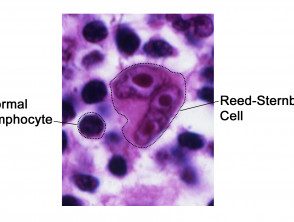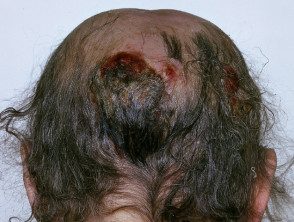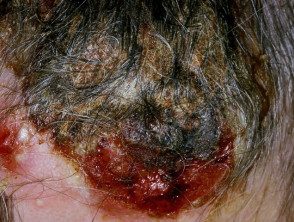What is it lymphoma?
Lymphomas are cancers that develop in the lymphatic body system. These cancers form when there is abnormal and excessive growth of B lymphocytes and T lymphocytes at lymph nodes and other parts of the body. There are many different subtypes of lymphoma, classified as Hodgkin lymphoma and non-Hodgkin lymphoma (NHL).
What is Hodgkin lymphoma?
Hodgkin lymphoma is a B-cell lymphoma characterized by a tumor cell called the Reed-Sternberg cell [1]. These are large abnormal lymphocytes with multiple nuclei found in the histology of the affected lymph nodes.
Reed-Sternberg cell

Source
Hodgkin lymphoma usually presents with painless inflammation of the superficial lymph nodes or with a asymptomatic mass on a chest x-ray. Hodgkin lymphoma patients occasionally present with severe generalized pruritus or with skin lesions.
How is Hodgkin lymphoma classified?
There are two different types of Hodgkin lymphoma according to the World Health Organization (WHO) Classification of hematopoietic and hematopoietic tumors. Lymphoid Fabrics [2]; these are:
- Classic Hodgkin lymphoma (95% of cases)
- Nodular lymphocyteHodgkin lymphoma prevalence (5% of cases).
Classic Hodgkin lymphoma is more histologically classified in:
- Nodular sclerosis classic hodgkin lymphoma
- Lymphocyte-rich classical Hodgkin lymphoma.
- Mixed Cellularity Classic Hodgkin Lymphoma
- Lymphocyte-depleted classic Hodgkin lymphoma.
Who gets Hodgkin lymphoma?
Hodgkin lymphoma is a relatively rare disease, accounting for approximately 0.6% of all cancers diagnosed in the developed world annually.
- Around 66,000 new cases of Hodgkin lymphoma were diagnosed worldwide in 2012.
- Around 75 New Zealanders are diagnosed with this disease each year. [one].
- the incidence Hodgkin lymphoma rates are highest in North America and lowest in East Asia [3]. This variation between countries may be due to different predominance risk factors, use of detection and / or diagnostic methods.
Hodgkin lymphoma develops in two main age groups.
- Hodgkin lymphoma is primarily diagnosed in young adults ages 15 to 35, but it can also develop in people over the age of 55.
- The younger age group tends to be more affected by the nodular sclerosis subtype. [4].
- Hodgkin lymphoma is generally more common in men, although the nodular sclerosis subtype is seen more often in women.
What causes Hodgkin lymphoma?
Hodgkin lymphoma is caused by a change in the DNA of a B cell lymphocyte. This mutation causes a lot of abnormal and large B cells accumulate in the lymphatic system and, over time, spread to other organs. It is not clear what causes the DNA mutation.
- A family history of a specific Hodgkin lymphoma subtype is most strongly associated with the risk of that subtype, supporting the likelihood of a genetic predisposition [5,6].
- The risk of lymphoma increases slightly in patients with chronic infections or autoimmune diseases
- Those with immunosuppression, such as people who have received long courses of chemotherapy for other diseases, or that are infected by viruses such as human immunodeficiency virus (HIV) or Epstein-Barr virus (EBV), also have an increased risk of developing lymphoma [7]. See also, associated with the Epstein-Barr virus lymphoproliferative disorders
What are the clinical features of Hodgkin lymphoma?
Hodgkin lymphoma usually begins within a single lymph node and then progresses to nearby lymph nodes through lymphatic channels before spreading to distant sites and organs [8,9]. It usually presents with painless inflammation of the superficial lymph nodes (in the neck, armpitor groin) or as an asymptomatic mass seen on a chest x-ray.
Some patients present to their doctors with nonspecific or "B" symptoms. They may have one or more of the following symptoms:
- Fevers
- Soaked night sweats
- Unintentional weight loss
- Lethargy.
Occasionally, patients may present with symptoms and signs that reflect organ involvement in the disease, such as:
- Jaundice and itching due to liver involvement
- Tetany (muscle spasms) due to high calcium levels
- Fatigue due to anemia
- Edema due to kidney involvement
Cutaneous manifestations of Hodgkin lymphoma
Direct cutaneous infiltration
- Cutaneous Hodgkin lymphoma is very rare.
- The chest is the most common site.
- It usually comes as dermal papules and plates.
- There may be only one nodule or a group of subcutaneous nodules.
- Lesions can ulcerate.
Nonspecific skin signs
Nonspecific skin signs include:
- General itching or excoriations
- Acquired ichthyosis (very dry skin)
- Hyperpigmentation
- Spontaneous urticaria.
Eczematized lesions.
- Eczematized lesions can be paraneoplastic.
- They are usually seen just before or at the time of diagnosis of advanced Hodgkin lymphoma associated with systemic nodal disease.
- Itchy papules or scaly or lichen plaques tend to be located along the drainage area of the affected lymph nodes.
- Lesions can be impetiginized due to staphylococci infection.
- They can be lonely groupedor (rarely) generalized [10–12].
Skin lesions in Hodgkin lymphoma.

Infected eczema

Infected eczema

Excoriations
How is Hodgkin lymphoma diagnosed?
A complete medical history and physical examination is the initial step in the diagnosis of Hodgkin lymphoma, which is confirmed by the presence of Reed-Sternberg cells in the pathological examination of a lymph node biopsy [8].
- A complete blood count and inflammatory markers are used to check for signs of anemia and inflammation.
- Lymph node evaluation may be a excision biopsy (where a complete lymph node is removed), a incisional biopsyThat is, where part of a lymph node is removed), or a central biopsy (where part of a lymph node is removed with a wide needle).
- A skin biopsy of an infiltrated nodule can be diagnostic of Hodgkin's disease in patients with direct skin infiltration with Hodgkin lymphoma. Typically, histology reveals Reed-Sternberg cells within an infiltration of small lymphocytes, histiocytes, eosinophilsand plasma cells.
Which is the differential diagnosis for Hodgkin lymphoma?
Any disease that occurs with enlarged lymph nodes with constitutional symptoms, such as fever and weight loss, should be considered in the differential diagnosis of Hodgkin lymphoma. [12].
No Hodgkin lymphoma
- NHL is difficult to differentiate clinically from Hodgkin lymphoma, and the diagnosis requires pathological confirmation.
- Hodgkin lymphoma tends to spread from one lymph node chain to another, while extranodal sites are generally involved in NHL.
- Hodgkin lymphoma patients tend to be younger than NHL patients.
Other malignancies
- Many malignant tumors can present with enlarged lymph nodes due to metastasis.
- Head and neck cancers can often spread to the cervical lymph nodes.
- Chest Cancer it commonly spreads to the axillary lymph nodes.
- The best way to differentiate Hodgkin lymphoma from other malignancies is to do a lymph node biopsy.
Infectious mononucleosis
- Enlarged lymph nodes in infectious mononucleosis are usually sensitive.
- Patients with infectious mononucleosis usually have a sore throat.
- The infection is diagnosed by the results of the blood count and is positive. serology for EBV.
Reactive lymph nodes
- Lymph nodes can also be enlarged from any infectious or inflammatory cause.
- These enlarged lymph nodes usually return to normal within a few weeks.
- When enlarged lymph nodes or symptoms persist, a lymph node biopsy may be considered to rule out Hodgkin lymphoma.
What is the treatment for Hodgkin lymphoma?
Treatment for Hodgkin lymphoma may include [12]:
- Chemotherapy
- Radiotherapy
- Surgery
- A combination of these options.
Chemotherapy involves taking oral tablets or injecting the medication into a vein or muscle, depending on the type and stage of the cancer being treated.
Radiation therapy can be used to treat solitaire or located Specific skin lesions For a pregnant woman with Hodgkin lymphoma, radiation therapy should be postponed until after delivery, if possible, to avoid any risk to the fetus.
- Other treatment options, especially for pregnant patients, include watchful waiting (monitoring) and systemic steroids.
- Treatments for Hodgkin lymphoma that are currently being evaluated include radiation therapy to stem cells transplant and monoclonal antibody therapy.
Non-specific skin symptoms can be treated with:
- Current corticosteroids
- Emollients
- Anti-itch creams
- Oral antihistamines for itching.
-
Antibiotics for secondary bacterial infection.
What is the result of Hodgkin lymphoma?
Hodgkin lymphoma can usually be cured if caught and treated early. the forecast Hodgkin lymphoma has improved in recent decades, with a current 5-year survival rate of more than 80%.
The prognosis largely depends on the following:
- The patient's signs and symptoms.
- Your age, sexand general health.
- The type of Hodgkin lymphoma
- The stage of the cancer.
Cutaneous Hodgkin lymphoma generally represents advanced disease and has a poor prognosis despite aggressive treatment [1].
